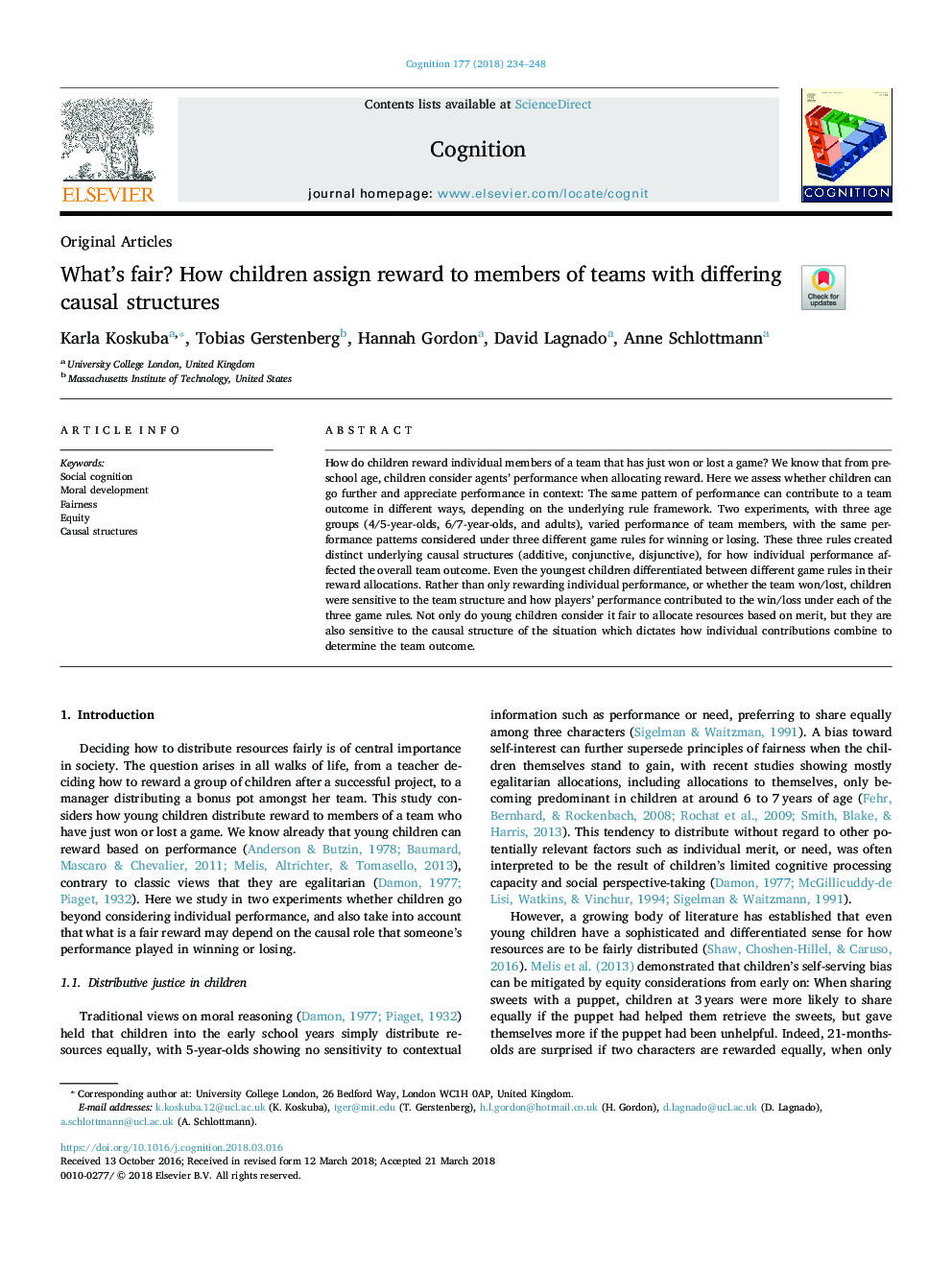| کد مقاله | کد نشریه | سال انتشار | مقاله انگلیسی | نسخه تمام متن |
|---|---|---|---|---|
| 7285327 | 1474090 | 2018 | 15 صفحه PDF | دانلود رایگان |
عنوان انگلیسی مقاله ISI
What's fair? How children assign reward to members of teams with differing causal structures
ترجمه فارسی عنوان
عادلانه است؟ چگونه کودکان به اعضای تیم با ساختارهای مختلف علمی متوسل می شوند
دانلود مقاله + سفارش ترجمه
دانلود مقاله ISI انگلیسی
رایگان برای ایرانیان
کلمات کلیدی
شناخت اجتماعی، پیشرفت اخلاقی، عادلانه، انصاف، ساختارهای علمی،
ترجمه چکیده
چگونه کودکان به اعضای فردی تیمی که فقط یک بازی را به دست آورده یا از دست داده اند، پاداش می دهند؟ ما می دانیم که از زمان پیش دبستانی، کودکان در هنگام تخصیص پاداش عملکرد کارکنان را در نظر می گیرند. در اینجا ما ارزیابی می کنیم که آیا کودکان می توانند بیشتر برسند و عملکرد را در زمینه در نظر بگیرند: همان الگوی عملکرد، بسته به چارچوب قاعده اساسی، می تواند به نتیجه های مختلفی کمک کند. دو آزمایش، با سه گروه سنی (4/5 ساله، 6/7 ساله و بزرگسالان)، عملکرد اعضای تیم را تغییر دادند، با همان الگوهای عملکردی که تحت سه قانون مختلف بازی برای برنده شدن یا از دست دادن در نظر گرفته شده بودند. این سه قاعده ایجاد ساختارهای متمایز اساسی متمایز (افزودنی، همبستگی، تفکیکپذیری) را برای اینکه چگونه کارایی فرد بر نتایج کل تیم تاثیر می گذارد، ایجاد کرد. حتی جوانترین کودکان بین قوانین بازی مختلف در تخصیص پاداش خود تفاوت دارند. کودکان به جای اینکه صرفا پاداش عملکرد فردی یا اینکه تیم برنده / از دست رفته بود، به ساختار تیم حساس بودند و عملکرد بازیکنان در هر کدام از سه قانون بازی به شکست / شکست کمک کرد. نه تنها بچه های جوان به نظر من عادلانه هستند که منابع را براساس شایستگی اختصاص دهند، بلکه آنها نیز به ساختار علیت وضعیتی حساس هستند که به نحوی که چگونه مشارکت های فردی برای تعیین نتایج تیم ترکیب می شود، حساس است.
موضوعات مرتبط
علوم زیستی و بیوفناوری
علم عصب شناسی
علوم اعصاب شناختی
چکیده انگلیسی
How do children reward individual members of a team that has just won or lost a game? We know that from pre-school age, children consider agents' performance when allocating reward. Here we assess whether children can go further and appreciate performance in context: The same pattern of performance can contribute to a team outcome in different ways, depending on the underlying rule framework. Two experiments, with three age groups (4/5-year-olds, 6/7-year-olds, and adults), varied performance of team members, with the same performance patterns considered under three different game rules for winning or losing. These three rules created distinct underlying causal structures (additive, conjunctive, disjunctive), for how individual performance affected the overall team outcome. Even the youngest children differentiated between different game rules in their reward allocations. Rather than only rewarding individual performance, or whether the team won/lost, children were sensitive to the team structure and how players' performance contributed to the win/loss under each of the three game rules. Not only do young children consider it fair to allocate resources based on merit, but they are also sensitive to the causal structure of the situation which dictates how individual contributions combine to determine the team outcome.
ناشر
Database: Elsevier - ScienceDirect (ساینس دایرکت)
Journal: Cognition - Volume 177, August 2018, Pages 234-248
Journal: Cognition - Volume 177, August 2018, Pages 234-248
نویسندگان
Karla Koskuba, Tobias Gerstenberg, Hannah Gordon, David Lagnado, Anne Schlottmann,
